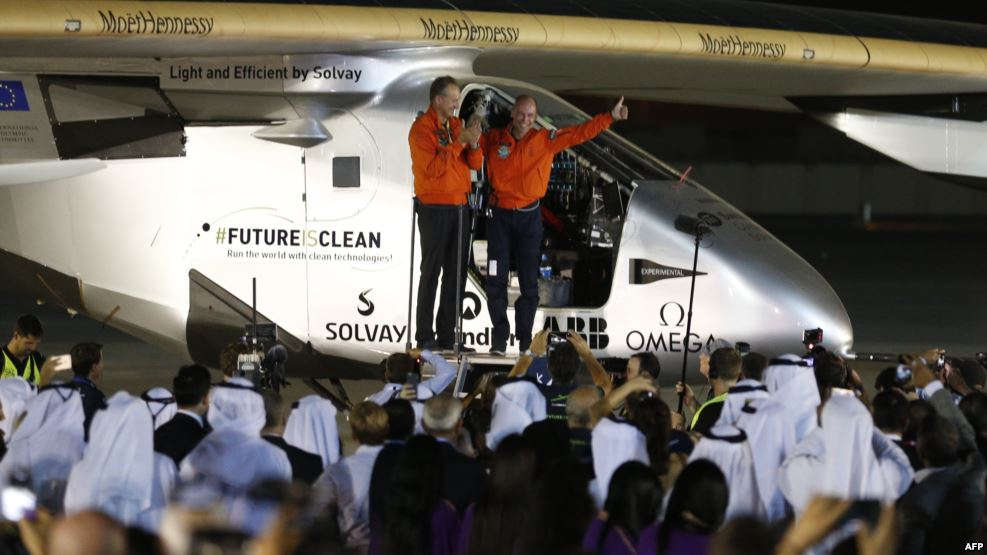
Solar-Powered Plane Completes Trip Around the World(6:31)
For the first time, a solar-powered airplane has completed a trip around the world.
The Solar Impulse 2 landed in Abu Dhabi before sunrise on Tuesday, after a trip that took 17 months and covered more than 42,000 kilometers.
Although poor weather conditions delayed the flight many times, energy from the sun provided all of the power required for the long and difficult journey.
Solar Impulse chairman Bertrand Piccard flew the plane during the final hours of the flight. Fellow pilot Andre Borschberg joined him in Abu Dhabi. The Swiss explorers hugged in excitement on completing the journey.
Piccard spoke to reporters after landing the plane. His words pointed not so much to the accomplishment of the long-distance flight, but to the future of the technologies involved.
“The future is clean. The future is you. The future is now. Let’s take it further,” Piccard told a crowd.
From the beginning, the project was meant to bring attention to clean energy and the technologies it requires.
In a statement, Picard said, “Our mission now is to continue to motivate people, corporations and government to use these same solutions on the ground wherever they make sense.”
He also spoke about the need to create an international agency for clean technologies. He said such a group could bring together policymakers and companies that develop solar, wind and fuel cell technologies.
The around-the-world flight was divided into 17 parts. The longest and most difficult part was from Nagoya, Japan, to Kalaeloa, in the American state of Hawaii. That trip took nearly five days. Co-pilot Borschberg set a world record for an uninterrupted flight alone.
A trip that was part exploration part, part technology test
The Solar Impulse 2 brings together several technologies that researchers are working to improve. The plane’s body is made of very light, but strong carbon fiber. The carbon design keeps the weight of the plane low. The whole aircraft weighs about as much as a car.
Yet, its wingspan is huge, measuring 72 meters from wing tip to wing tip. That is greater than a 747 passenger Jet.
Most of the Solar Impulse 2’s wings and body are covered with more than 17,000 photovoltaic cells. Four batteries keep the plane’s four engines operating for nighttime flight.
The plane set several records for distance and time in the air. However, traveling at 45 to 90 kilometers an hour, the aircraft is anything but fast.
The flight began in Abu Dhabi, one of the United Arab Emirates, on March 9, 2015. But the effort started more than 10 years earlier. The first test flight took place in 2009.
Since then, there have been several versions of the Solar Impulse plane.
Piccard and his team faced many technical problems, especially with the design of the batteries. The batteries permit energy to be stored when the sun is not shining.
Growing costs also threatened the project. Last year, Picard told the Guardian newspaper that the solar plane project cost about $170 million dollars.
The project showed many of the difficulties facing solar flight. Weather and equipment failures kept the plane grounded for long periods of time.
Some experts believe these problems can be solved with further research.
Ron Bishop is an aviation expert with Central Queensland University in Australia. He told VOA’s Victor Beattie that there were ways to design solar airplanes to overcome the technical problems.
One way might be to use hybrid technology. Hybrid means bringing two power sources into one system.
“What we could probably see is a hybrid, so possibly an aircraft that takes off with a jet engine and then once it gets to altitude it can run on the solar or on batteries.”
Earlier this week, co-pilot Andre Borschberg said the flight had already proven that long distance air travel is possible without creating pollution.
“By flying around the world thanks to renewable energy and clean technologies, we have demonstrated that we can now make our world more energy efficient,” he said.
I’m Mario Ritter.
This story is based on reporting by Smita Nordall of VOA News and other materials. Mario Ritter adapted it for Learning English. George Grow was the editor.
_____________________________________________________________
Words in This Story
journey –n. a trip, to travel from one place to another
accomplishment –n. to have reached a goal, to have accomplished something
motivate –v. to give a reason to do something
photovoltaic –adj. related to making electricity from light
aviation –n. related to flying devices
hybrid –adj. something formed by combining two or more things
